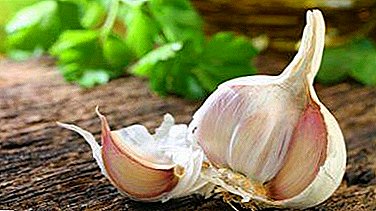 If you notice that your rabbit is constantly scratching or shaking its ears, you should carefully examine it and check for the presence of scabies. This contagious disease can cause a lot of problems for your animals, so do not delay treatment. Consider what types of scabies can be in rabbits, how to diagnose and treat them, and get acquainted with their prevention.
If you notice that your rabbit is constantly scratching or shaking its ears, you should carefully examine it and check for the presence of scabies. This contagious disease can cause a lot of problems for your animals, so do not delay treatment. Consider what types of scabies can be in rabbits, how to diagnose and treat them, and get acquainted with their prevention.
Varieties
There are several types of scabies in a rabbit, caused by various mites, from the name of which the name of these diseases derives. The emergence of these diseases contributes to the crowding of rabbits, high humidity, the presence of other infectious diseases. Most often they are diagnosed in the offseason.
Did you know? On Earth, there are about 54 thousand species of ticks belonging to the class of arachnids. Parasites for mammals is only a small part of them.
Notodrosis
Causative agent. Mites of the genus Notoedres, having a rounded body of gray tone and small dimensions (0.2-0.45 mm). Usually rabbits affect the Notoedres cuniculi variety, but there are also Notoedres cati lesions that can parasitize also on cats and dogs. The latter species can live on a person for up to 30 days and cause scabies in it, but is unable to reproduce in the human epidermis.
Development cycle. These mites live and breed in the thickness of the rabbit skin epidermis and die outside it at an ambient temperature of + 15-20 ° C after about 12 days. The eggs of these parasites are more resistant. In the course of the life cycle, the parasites pass through several phases: the egg, the larva, the nymph (protonimph and teleonym) and the adult (imago). It takes about 2-3 weeks.  Source and path of infection. The most common infection occurs from a sick animal and most quickly spreads when crowded in cages. This type of scabies can also be transmitted through the litter, household items, which were ticks from the carrier.
Source and path of infection. The most common infection occurs from a sick animal and most quickly spreads when crowded in cages. This type of scabies can also be transmitted through the litter, household items, which were ticks from the carrier.
Incubation period. May last from 10 to 15 days.
We recommend to get acquainted with the diseases of rabbits, methods of their treatment and prevention, as well as to learn what diseases of rabbits are a threat to human health.
Symptoms. Initially, focal lesions appear on the nose, in the lips, at the bases and along the edges of the auricles. Then these zones expand and merge with each other. The skin at the same time peels, thickens, loses elasticity, covers the body with folds. In the wool appear bald patches, covered with grayish-brown crusts and scabs. Rabbits comb pruritic lesions before wounds. With severe development of the disease in animals, appetite is significantly reduced, which leads to exhaustion and death.
Sarcoptosis
Causative agent. Mites Sarcoptes cuniculi, which also have a rounded body with short limbs. Their size is about 0.4 mm, and on the back there are many grooves.
Development cycle. They develop and multiply in the thickness of the skin, gnawing in it moves and feeding on the cells under the horny layer of the epithelium. Females lay from 2 to 7 eggs, of which after 3-5 days the larvae appear, then passing through the stages of nymphs and imago.  Source and path of infection. It is transmitted by contact of an infected animal with a healthy one, through bedding, dishes and other household items. Can be brought on the clothes of a person in contact with a rabbit, a patient with scabies.
Source and path of infection. It is transmitted by contact of an infected animal with a healthy one, through bedding, dishes and other household items. Can be brought on the clothes of a person in contact with a rabbit, a patient with scabies.
Incubation period. May last from 14 to 20 days.
Symptoms. First, the skin on the head and neck is affected, then the disease spreads to other parts of the body, starting with the paws. The affected areas are covered with small nodules that eventually turn into pustules (abscesses) or vesicles. The skin at the same time itches, the rabbit combs it to wounds. The skin thickens, loses its elasticity, and the fur falls out. In advanced cases, rabbits eat very little, lose weight and die.
It will be helpful for beginner breeders to read about how to choose a rabbit when buying, how to determine the sex of the rabbit, and what affects the lifespan and how long the rabbits live on average.
Psoroptosis
Causative agent. Mite Psoroptes cuniculi, having an oval shape with dimensions of 0.3-0.9 mm, yellowish body tones, 4 pairs of limbs.
Development cycle. They parasitize inside the auricle of rabbits, but with a severe form they can transfer to other parts of the body. These ticks die in the external environment only for 22-24 days. Females lay eggs, from which in a few days the larvae appear, passing through two stages of nymphs (protonymphs and teleonymphs), before reaching an adult state (imago). It takes from 9 to 14 days.  Source and path of infection. They are transmitted from a sick animal to a healthy one, as well as from bedding and household items that have been in contact with a rabbit infected with a tick.
Source and path of infection. They are transmitted from a sick animal to a healthy one, as well as from bedding and household items that have been in contact with a rabbit infected with a tick.
Incubation period. Lasts 15-24 days.
Symptoms Rabbits shake their ears, rub them on the cage. In the mild form of the disease has a focal localization. First, red bubbles appear, bursting on the first or second day. At the same time, a yellowish liquid is released from them, which then dries out and forms crusts.
In the outer part of the auditory meatus, brownish-yellow sulfuric lumps appear in greater numbers than usual. In severe form, the lesions increase, merge with each other, capture most of the auricles and external auditory passages, where the accumulation of purulent masses gradually occurs.
Did you know? The length of the ears in rabbits depends on their variety, and each of them rotates without bundle of one with the other. The longest ears, according to the Guinness Book of Records, were 79 cm in size and were recorded in 2003 in the US state of Kansas at the national exhibition of rabbits.Psoroptosis can move to other parts of the head. This form can be complicated by secondary inflammations that can spread to the animal's brain, which leads to signs of CNS damage and death.
Video: rabbit ear scab treatment
Diagnostics
The diagnosis is made on the basis of the following indicators:
- symptoms;
- epizootological data;
- laboratory tests - for them taking scrapings from lesions for further research under the microscope.
Familiarize yourself with the best representatives of decorative, fur and down rabbit breeds.
You can examine the animal yourself, pay attention to the symptoms and try to look at lesions with a magnifying glass.
In this case, for your own research you will need:
- petrolatum;
- tool for taking scrapings from the affected area;
- small clear glass;
- magnifier or microscope.
 For self diagnostics, the following steps are performed:
For self diagnostics, the following steps are performed:- Petroleum jelly is heated to +40 ° C (body temperature of rabbits).
- A scraping from the lesions of the chosen instrument is taken and placed in a warm petroleum jelly in which the mites become more active.
- A mixture of vaseline with the taken biomaterial is neatly distributed over the glass.
- Glass with scraping under magnifying glasses or devices is carefully considered. If you see a lot of swarming small parasites, then the version of scabies will be confirmed.
Important! When scabies are found in rabbits on a farm, all workers should be instructed on the rules of individual protection, since scabies is contagious not only for the animals, but also for humans.In case of significant damage to the ears, it is necessary to consult a veterinarian, as the following additional tests may be necessary for diagnosis:
- examination of the middle ear otoscope;
- x-ray or tomography.
Treatment and control measures
First of all, when treating scabies of sick rabbits, they are isolated from healthy ones, and all ears, which were kept or in some way in contact with the sick animal, should be treated with acaricides (eg, Neocidol spray). 
Veterinary drugs
For psoroptesis (earwash), use Acrodex. If this drug is acquired in the form of an aerosol, then it is sent to areas that are affected by scabies, at a distance of 40-50 cm and treated for 2 seconds.
To soften the formed crusts and scabs, apply 10% Creolin emulsion, as well as Lysol on sunflower or linseed oil, 2% lugol ointment, 5-10% creolin or carbolic oil. Affected areas can also be lubricated with a mixture of green soap with sunflower oil in a 1: 1 ratio.
After the softened crusts are removed from the ears of rabbits using a 3% hydrogen peroxide solution. For the treatment of notohedrosis (itchy scabies), the following drugs are used: Hexalin, Hexatalp, TAP-85, Hexachlorane mineral-oil emulsion, activated by Creolin. They are used in the form of aqueous solutions.
We advise you to read about how to choose a rabbit when buying, how to determine the sex of the rabbit, as well as what affects the lifespan and how much the rabbits live on average.
A popular treatment for notohedrosis in rabbits is a 0.2% Neocidol emulsion solution, which is a colorless or pink colored liquid and contains 60% diazinon. Bath solution is prepared, observing the following proportions: 334 g of Neocidol are taken for 100 l of water.
First, the required amount of the drug is diluted with water in a ratio of 1:10, and then the resulting concentrated solution is added to the rest of the water in the bath.  Prior to the mass treatment of diseased animals, ten rabbits are selected first and the procedure is carried out. If, after treatment, they did not show signs of toxicosis or intolerance to such an agent, then all rabbits can be treated.
Prior to the mass treatment of diseased animals, ten rabbits are selected first and the procedure is carried out. If, after treatment, they did not show signs of toxicosis or intolerance to such an agent, then all rabbits can be treated.
The temperature of the water in the bath should be about + 32-35 ° C. The rabbit is completely immersed in such a bath for a minute, but the head is set aside outside. The skin is stroked in the direction from the tail to the head, and on the legs - from the bottom to the top.
This is done so that the entire skin is well soaked in the liquid. Then the head of the rabbit for a couple of seconds down into the water. At the same time be sure to pinch the nostrils and mouth of the animal with the palm. Then the head is lightly massaged.
Important! Pregnant rabbits for 15 days before the rabbit, as well as rabbits up to 30 days of life in the processing of such drugs is prohibited.
The skin areas that are heavily affected by scabies, subjected to additional processing with a brush. After taking the bath, the hair coat is well wrung out, and the animal is placed in a warm and pre-disinfected room.
After treatment of 30 adult individuals or 60 rabbits with an age of 1.5-2.5 months, the contaminated bath solution should be replaced with a new one. The prepared solution for treatment against scabies should be applied on the same day, because the next day the liquid is no longer suitable.  During bathing animals must wear rubber gloves, and during the procedure you can not eat or smoke. After washing the rabbits, wash your hands thoroughly with warm water and soap. Neocidol can also be used as an aerosol.
During bathing animals must wear rubber gloves, and during the procedure you can not eat or smoke. After washing the rabbits, wash your hands thoroughly with warm water and soap. Neocidol can also be used as an aerosol.
Spraying is carried out at a distance of about 50 cm from the animal while spending 20-40 ml per individual, depending on the lesion sites. Rabbits in this procedure should be in the cells, which are also treated with an aerosol. The ambient air temperature should not be below +20 ° С, and the aerosol temperature should be + 22-25 ° С.
Rabbits that are sick with scabies are treated twice with an interval of 8-10 days. And healthy individuals that were in contact with sick animals were treated in this way once.
It will be useful for you to learn more about the treatment of rabies ears.
For the treatment of sarcoptosis (pruritic scabies) in rabbits, Fenothiazine with fish oil, SC emulsion preparation, Hexalin, Hexatalp, TAP-85 is used. In the cold period, a dust of colloidal or finely dispersed sulfur with a substance content of 80-95% is used for treatment.
This means sprinkle all the wool so that it fell on the skin. Slaughter of rabbits after treatment with hexachlorane agents is allowed to be carried out only after two months, when using mineral oil emulsion of Hexachlorane - after 40 days, after applying Neocidol - 20 days. 
Folk remedies
In the treatment of ear scabies (psoroptosis) use the following folk remedies (as ancillary):
- Turpentine, better mixed with sunflower oil, in a ratio of 1: 1. Such a mixture of rubbed ears scabby rubbed so that the crusts are well soaked. Then the ears are cleaned with hydrogen peroxide. After 6-7 days, this procedure is repeated.
- Caraway or anise oil (10%) is used to soften crusts.
For the treatment of acne scabies apply turpentine, which is treated affected areas, or birch tar.
Prevention
The following measures are taken to prevent the disease:
- they treat not only sick, but all healthy animals;
- Avoid crowding pets, do not allow rabbits to contact other animals;
- cells, inventory, aviary, walking with Creolin solution (0.5%) are regularly disinfected;
- burn with a blowtorch or flamethrower cells and other equipment;
- do not use other people's rabbit care products;
- after contact with the diseased animal, they wash their hands well, use replacement clothes, which must be washed afterwards;
- provide good nutrition to rabbits, including the necessary vitamins that help strengthen the immune system;
- they conduct routine examinations of animals at the veterinarian, which allows to detect the disease at an early stage.

Be attentive to the health of your pets, and at the first symptoms of scabies, consult a doctor and begin treatment of animals. Launched forms of the disease can end up badly for rabbits. To prevent scabies, preventive measures should be taken and sanitary and hygienic conditions of animals should be kept.












